At any Bukharian table, the first course you are served will be a plethora of salads. Some of them, you will be told, are Korean, such as kimchi or spicy carrot salad, but what you might not realize is that most of those bear Russian names. A tourist commented on Tripadvisor that it was strange to hear ethnic Koreans speaking Russian in Bukhara and Samarkand. It is even more strange for me to see a traditional Uzbeki / Bucharian round flat bread non called lepyoshka, or a Korean spicy carrot salad labeled markovka – both are Russian translations. This mystery is resolved very simply: Stalin’s great “ethnic cleansing” which started the moment he came to power in 1926 and culminated in 1937, the year of the purges, with massive deportation of the entire ethnic groups to far regions as “non-reliable.” Koreans, who mostly lived in Russia in Ukraine since 19th century, were summarily moved to Central Asia and ordered to work on kolkhoz, collective farms.
Apparently, Bukharian fondness for salads of all kinds connected them with transplanted Koreans who have a magic hand in growing vegetables. My grandmother used to reminisce about huge sweet “Korean onions” and enormous carrots with rounded ends. So this one is explained. Next, who are Bukharians? If you look at the map, Bukhara is a city in Uzbekistan, former Soviet Union. Its population is currently listed as close to 300,000. Yet there are more than 70,000 Bukharians living in the U.S. and only about 1,500 in Uzbekistan. Who are those Bukharians if they are not a part of Bukhara statistics?

Those are Jews who have started traveling and trading along the Silk Road (the name Silk Road was given to it much later) three millennia ago, during the reign of King David. When Persian King Cyrus liberated them from Babylonian captivity, he encouraged them to populate Central Asian territories since he relied on their loyalty. They permanently settled in the area that later, in the Middle Ages, became the Emirate of Bukhara, where they constituted one of the largest, and perhaps the most significant segment of population.The community called itself Israelite. The Emirate of Bukhara fell to the “dictatorship of military communism” (I am quoting Lenin!) in 1920, the fantastically beautiful city of Bukhara was brought under the jurisdiction of Uzbekistan, but the designation Bukharian that actually meant Jewish population from that region, has stuck, since all names associated with any religion were forbidden.
They have faced horrendous persecution during the Soviet regime, so they were among the first who made aliyah to Israel where they joined their compatriots who had moved to Jerusalem in 19th century. They have faced another wave of even worse persecution when the Soviet colossus collapsed, and the rest of them migrated, mostly to Israel, but also to the U.S. Most of them are religious people, many believe that they are descendants of the two lost tribes, Naftali and Issachar, so most of the Bukharian restaurants are kosher. You still have to check for the hecksher, though, but if it is, in fact, reliable, the food is exquisite!
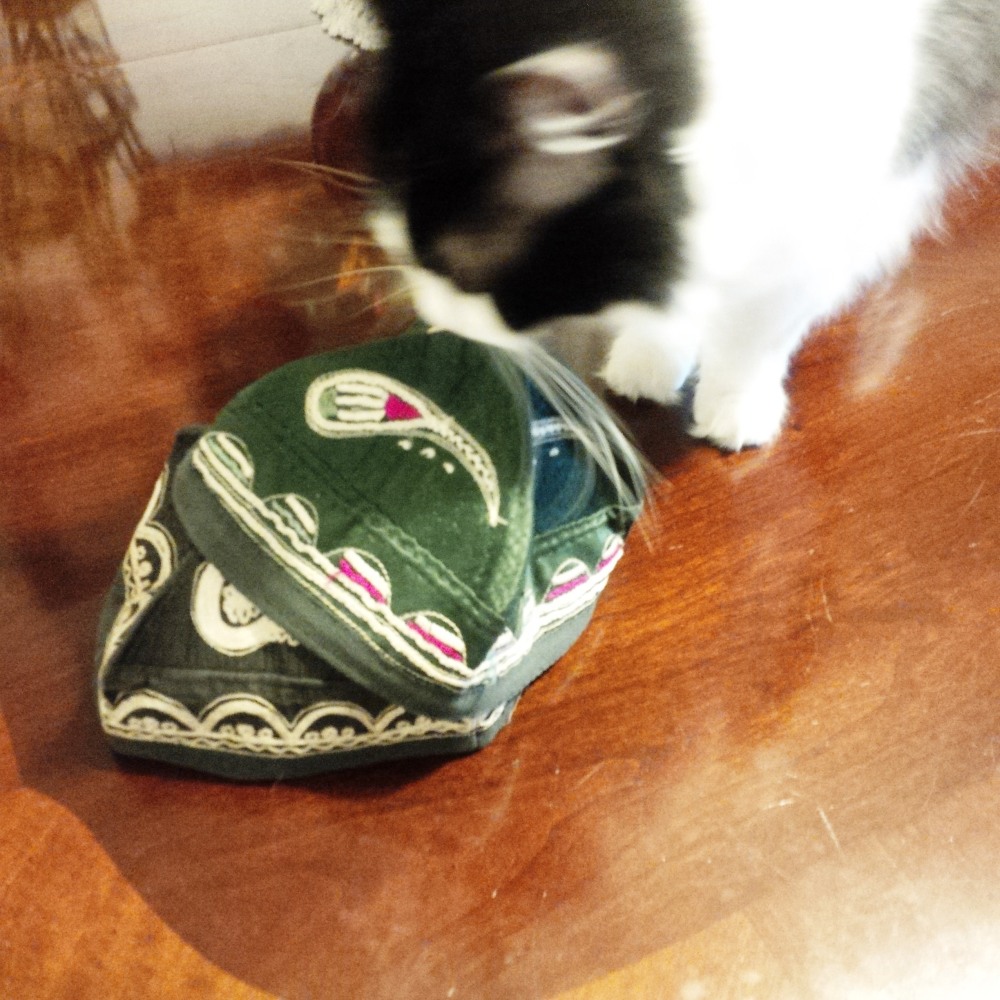
Curious Beba is exploring gorgeous silk embroidered Bukharian yarmulkes, or kippos, brought by my grandfather Oleve v’Sholom from Tashkent (capital of Uzbekistan, next door to Bukhara) where he had been recovering from wounds during WWII. I treasure them not only as a memento, but also as a live example of the ancient Silk Road, a trade route from China through Asia to the Mediterranean.
I was assured that this salad is truly Bukharian, as proven by its name. Uzbeks call it a traditional Uzbeki salad, as proven by its name. Since I don’t know either Bukhori (the language of Bukharian Jews) or Uzbek language, I won’t argue. I just cook. We called it Bukharian and had it almost every day during the summer, when fat and juicy fontanskiye tomatoes were bursting out of their skins, and dill – glorious dill! – made its fragrant way into every dish, from herring to stews.
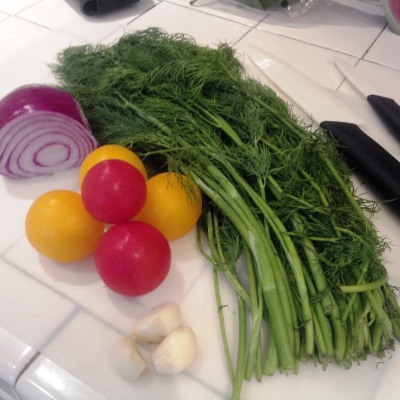
The secret of it is in paper-thin slicing of every ingredient. There are only three of them, tomatoes, onion, and garlic. Traditionally, it also contains hot pepper, and in some recipes, basil, parsley, or cilantro are used, rather than dill. I prefer to use lots of garlic – Dracula will never visit this house! – and tons of fresh dill. It comes out quite spicy, but also delicate and not overwhelming.
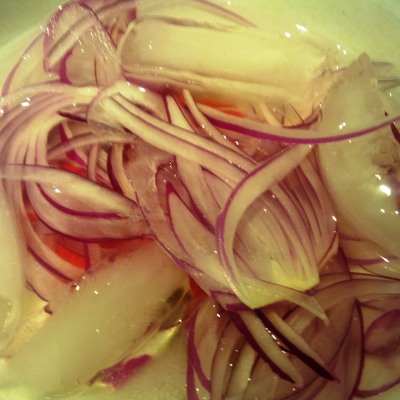
Onion is sliced first, then soaked in cold water for a few minutes. Since cold water in South Florida pipes is very relatively cold, I add a few ice cubes to it. This takes bitterness out of the onion while adding crispness.

Tomatoes come next. I had this bunch of heirloom tomatoes, red and yellow, small but delicious, so I used them. I have to thank my husband for slicing everything while I was taking pictures. Paper-thin slicing is his specialty!
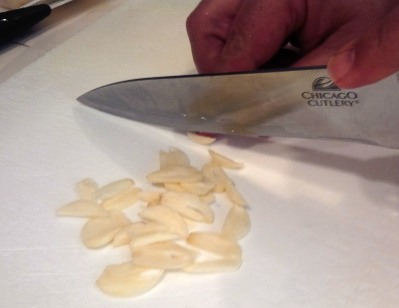
While he was slicing garlic, I drained and dried onion slices (you have to dry them really well), and placed both sliced onion and sliced tomatoes into a serving bowl. Once garlic is added, the only thing left before dressing is dill.
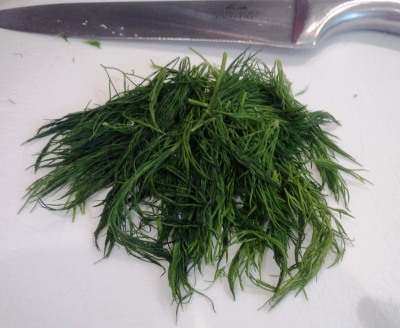
Do you see how much dill I am marrying with five little tomatoes? It almost becomes a dill and garlic salad flavored by tomatoes and onions. It’s up to you, of course, to adjust the flavoring to your liking. You can chop the dill coarsely, but I prefer to tear it, so as not to bruise it with a knife.

Give it a generous portion of freshly ground black pepper, some sea salt, olive oil and light wine vinegar, mix and let it sit for at least 10 minutes before serving, to absorb the flavors. It looks gorgeous in a clear shallow bowl, and I do serve hot peppers on the side, for adventurous guests.
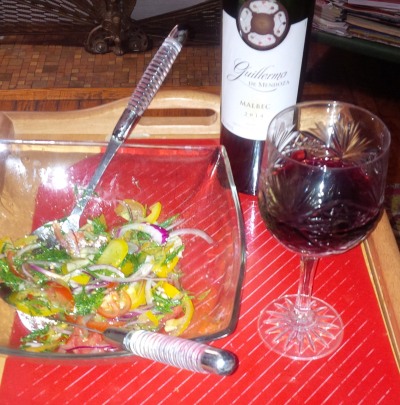
We had it as an appetizer before dinner, with Guillermo de Mendoza Malbec 2014, a nice dry medium body wine from Argentina, with blackberry and chocolate notes characteristic to Mendoza region wines, and, as far as I know, the only kosher one produced there. Odedi’s Wine Reviews has reviews of other Mendoza wines, but not this one, so I am in the dark – please enlighten me!
INGREDIENTS
- 1 lb large or medium size ripe tomatoes
- 1/2 medium size red onion
- 4 – 5 garlic cloves
- Large handful of fresh dill
- 1 tablespoon olive oil
- 1 tablespoon light wine vinegar
- Salt and pepper to taste
- Optional hot peppers
PROCEDURE
- All ingredients must be sliced paper thin.
- Slice onion, place in a bowl with ice-cold water for a few minutes.
- Slice tomatoes, place in a serving bowl.
- Drain and dry onion slices thoroughly, mix with tomatoes.
- Slice garlic cloves, add to the bowl.
- Tear dill or chop coarsely, add to the bowl.
- Dress with oil and vinegar, season with salt and freshly ground pepper.
- Mix gently and put on the side for at least 10 minutes before serving.
Enjoy!

That looks delicious!
LikeLiked by 2 people
So does your 4th of July BBQ! Thanks for stopping by and for the like!
LikeLiked by 2 people
I love the bits of history you include with the recipes. Fascinating!
LikeLiked by 3 people
Thank you so much!
LikeLike
Reblogged this on koolkosherkitchen and commented:
Today’s Word Prompt is GLORIOUS. I am repeating this simple salad made delicious by lots of GLORIOUS DILL and some glorious history of people largely forgotten. https://dailypost.wordpress.com/prompts/glorious/
LikeLiked by 2 people
Thank you for a pingback.
LikeLike
This would be a very different salad for me. I look forward to trying it when fresh ingredients are plentiful and inexpensive. Can’t help you with the wine, however.
xx,
mgh
LikeLiked by 1 person
You don’t need to help me with wines; I am doing reasonably well in that department, but why? You don’t like wine?
LikeLiked by 1 person
I love wine – I was referring to your comment asking for some help with details about the one you served. I don’t know it.
xx,
mgh
LikeLiked by 1 person
Ah, I see. That was meant to be picked up by my wine expert Odedi at https://winesipping.wordpress.com.
LikeLiked by 1 person
Ah!
LikeLiked by 1 person
My husband is my go-to for paper think cutting too …. I always say he would have made a great surgeon! This looks SO delicious. So sad that the history of these people is less than palatable. I wish them peace.
LikeLiked by 2 people
I share your sentiments, and luckily, most of them now live well and prosper in various parts of the world.
LikeLiked by 2 people
And now we have new Stalin’s… when does it end this raping peoples lives in the thin disguise of political ideal? Rhetorical … no answer required unless it’s a magic wand 🙂
LikeLiked by 1 person
I am and wand-less magical cat; cats don’t usually carry wands, sorry!
LikeLiked by 1 person
😿
LikeLiked by 1 person
Reblogged this on Die Erste Eslarner Zeitung – Aus und über Eslarn, sowie die bayerisch-tschechische Region!.
LikeLiked by 1 person
Thank you for reblogging.
LikeLiked by 1 person
Thank you for another nice recipe, and have a nice week. 😉 Michael
LikeLiked by 1 person
You too, Michael! 😸
LikeLike
Lovely!! I do love learning history, and the stories from you!! I just wish I was at your house, to hear them first hand, and to eat!!
LikeLiked by 1 person
I wish you were, my favorite purple person! 😻
LikeLiked by 1 person
Maybe 1 day?? Who knows??
LikeLiked by 1 person
We live and hope and pray!
LikeLiked by 1 person
Dear Esme, I am so grateful to you for mentioning me again. I hope you are doing well!
LikeLike